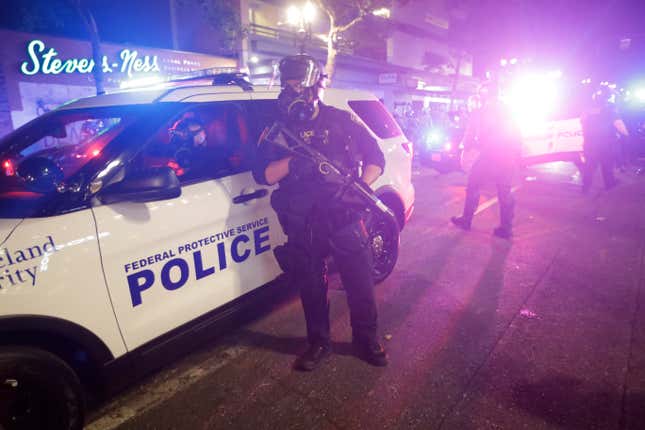
In light of the charges filed against former Louisville Metro police officer Brett Hankison in Kentucky last week, civil liberties advocates and news outlets have taken a harder look at how police and prosecutors’ offices have been charging Black Lives Matter protesters arrested during nationwide demonstrations this year. Among them is the news website Insider, which analyzed some of the more than 13,000 arrests that have taken place during the protests. According to civil liberties experts, the severity of the charges protesters are facing is “deeply disturbing” and “atypical” compared to their crimes.
The article focuses on one case in particular: Colinford Mattis and Urooj Rahman, two nonwhite protesters (Mattis is Black) who could be punished with life in prison for throwing a molotov cocktail at an empty police van in Brooklyn. N.Y., in May.
Rather than being charged with a low-level offense, Mattis and Rahman were charged with arson in interstate commerce; the “interstate commerce” aspect, as Insider notes, means the pair are now accused of a federal crime, bringing with it a heftier sentence.
This is unusual, according to legal experts. Interstate-commerce violations typically involve trafficking weapons across state lines or kidnapping. So why did those charges apply to Mattis and Rahman?
Here’s how one legal expert summarized it to The Appeal:
“I think this is a really crazy prosecution,” said Rachel Barkow, a New York University law professor who sat on the U.S. Sentencing Commission from 2013 to 2018. Barkow noted that in their May 30 indictment, prosecutors argued that damaging a local police car is federal crime because NYPD is “an institution and organization receiving federal financial assistance” and that “the NYPD and New York City government conduct business in interstate commerce,” including “purchasing vehicles and other equipment and supplies” from other states. “Why is this federal?” Barkow asked rhetorically. “The theory that the car is an ‘instrument in interstate commerce’ seems like an enormous overreach.”
According to Insider, which cites the FBI’s own statements, more than 13,600 protesters have been arrested during this year’s racial justice and police accountability protests. Last Thursday, the Department of Justice said more than 300 people in 29 states had been charged with federal crimes connected to the demonstrations. These include charges of arson, assault, and destruction of property.
Of those 300 people, 76 were hit with “interstate commerce” violations—constituting about 25 percent of all federal cases.
Samuel Spital, the director of litigation at the NAACP Legal Defense and Educational Fund, told Insider these kinds of charges against protesters were “deeply disturbing.”
Meanwhile, Michael Loadenthal, a professor at Georgetown University and the executive director of the Prosecution Project, told the publication that, though the charges weren’t exactly unprecedented, they were “certainly atypical.”
Attorney General William Barr, who has been overseeing the DOJ’s response to BLM protests around the country, recently disparaged the movement, saying protesters were “not interested in Black lives.”
“They’re interested in props―a small number of Blacks who were killed by police during conflict with police, usually less than a dozen a year―who they can use as props to achieve a much broader political agenda,” Barr said at an event at Hillsdale College in Michigan earlier this month.
According to the Washington Post’s Fatal Force database, which has tracked fatal police shootings since 2015, 250 Black people were shot and killed by police in 2019. Thus far in 2020, 142 Black Americans have been killed at the hands of the nation’s police forces. But while these numbers will include people like Breonna Taylor and Elijah McClain, they exclude George Floyd, Daniel Prude or Jacob Blake. Floyd and Prude weren’t shot, but died from asphyxiation caused by their violent arrests, while Blake, who was shot in the back seven times last month, survived his encounter with Kenosha police.
Overall, the rate of fatal police shootings this year remains unchanged compared to 2019, with an average of 2.7 people a day dying at the hands of officers, despite a pandemic that required many Americans to shelter-in-place for months.

